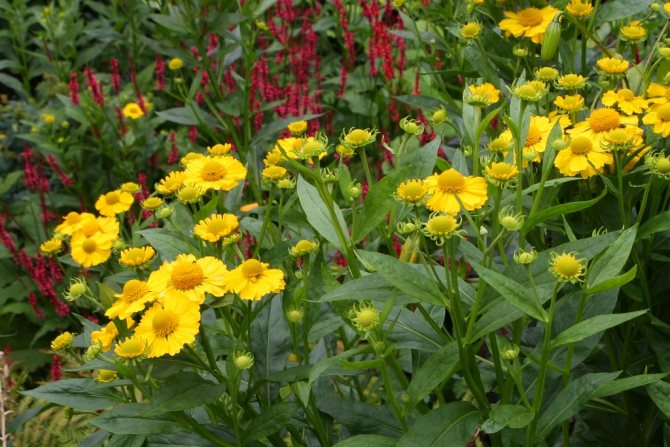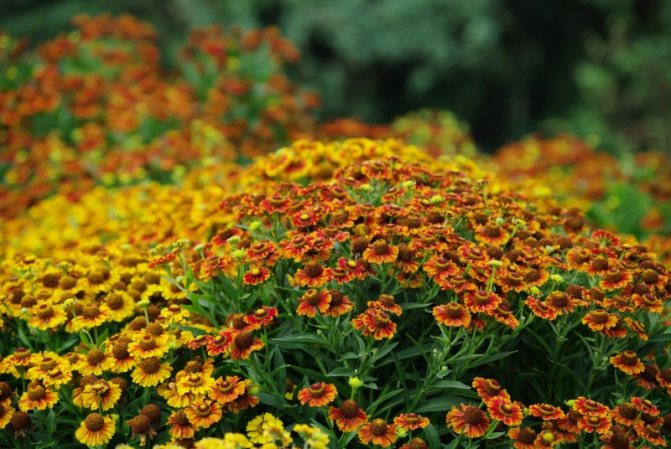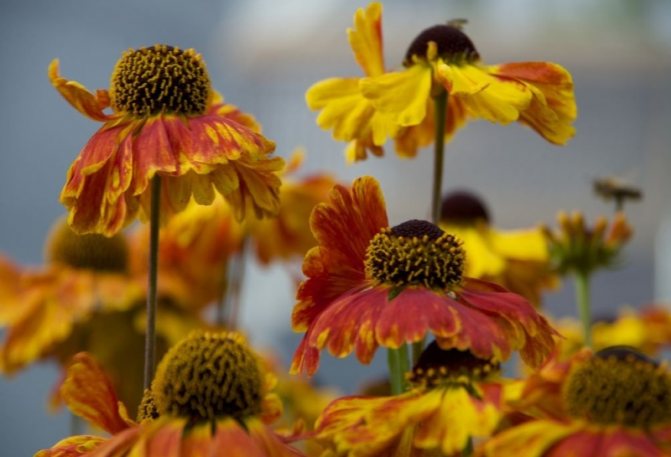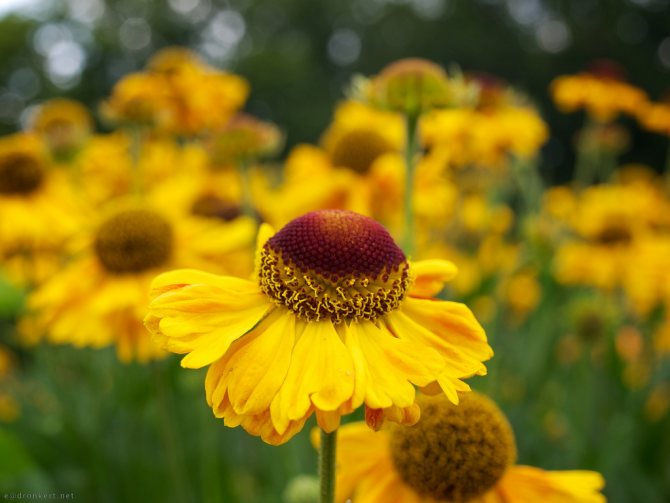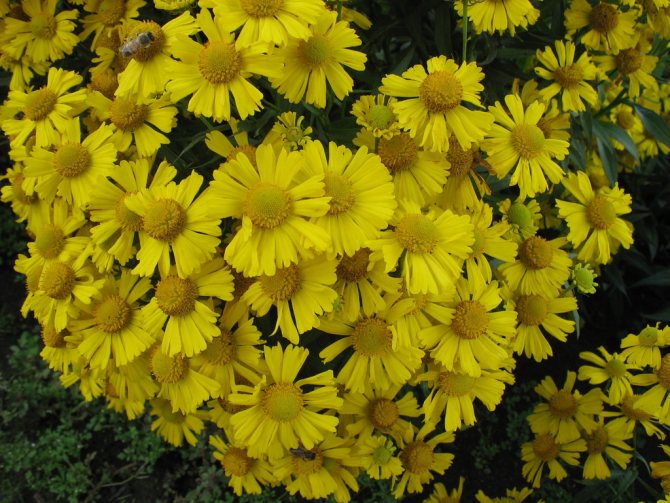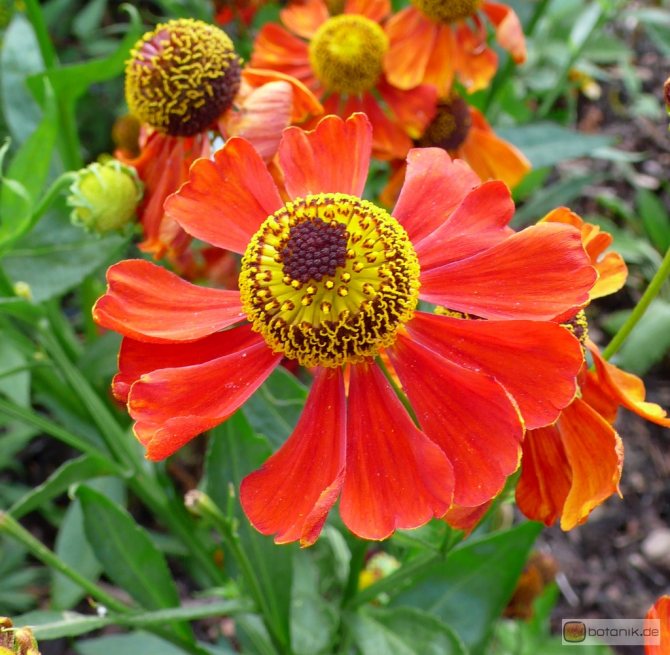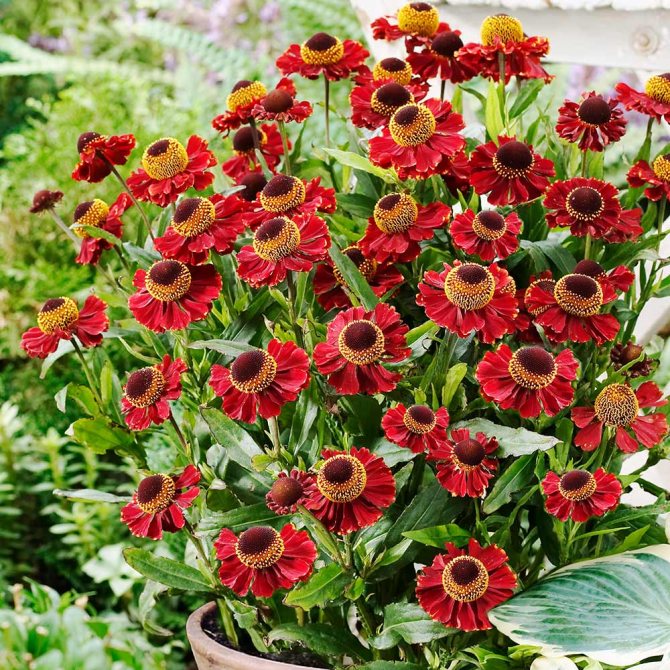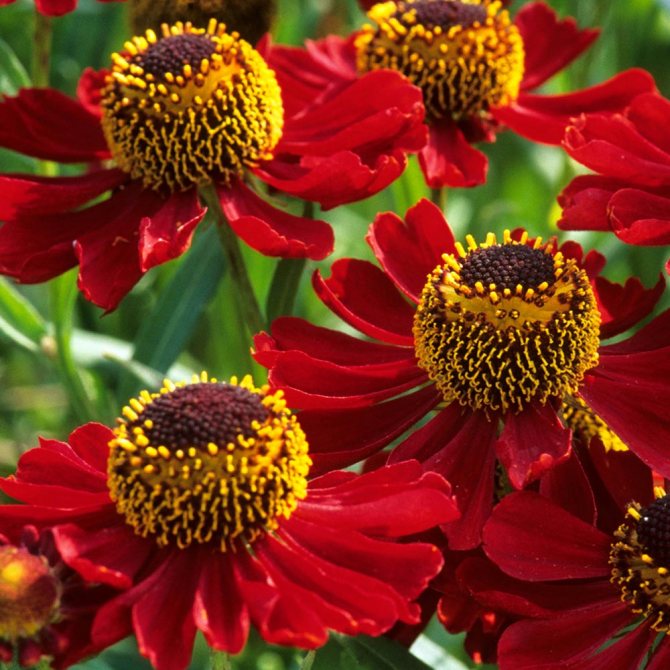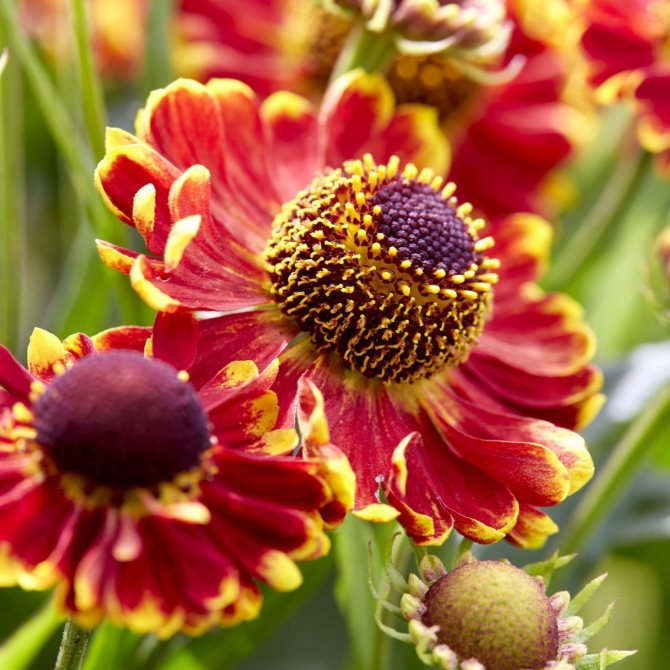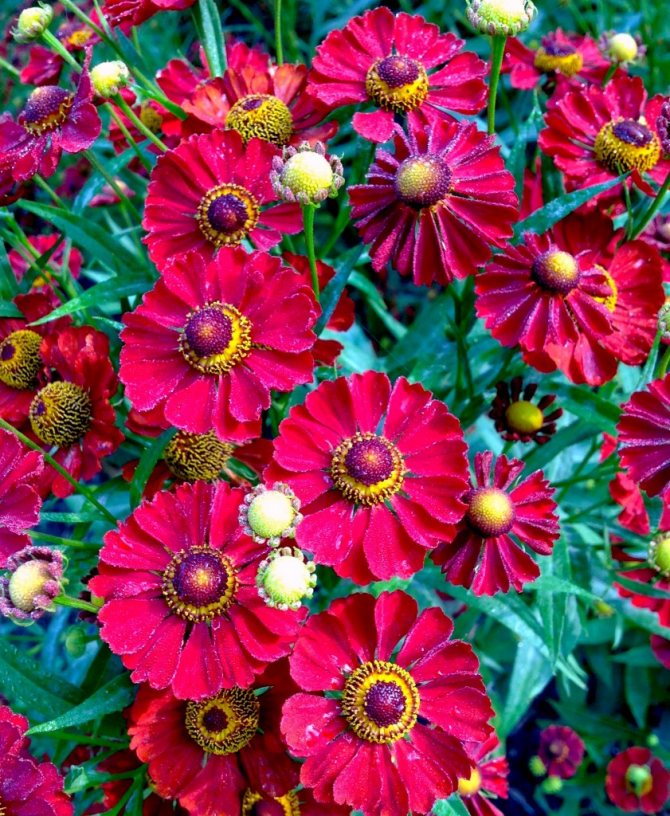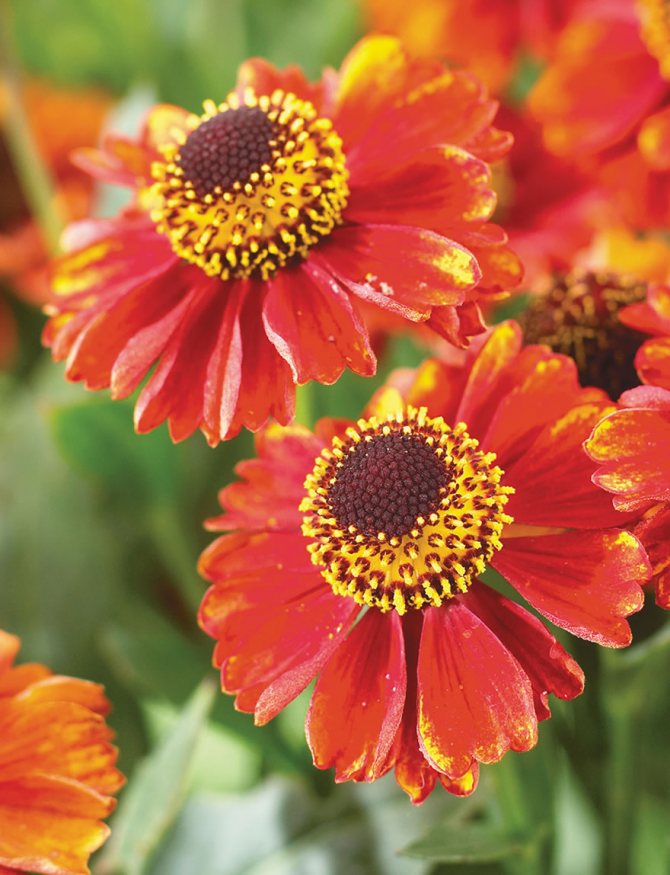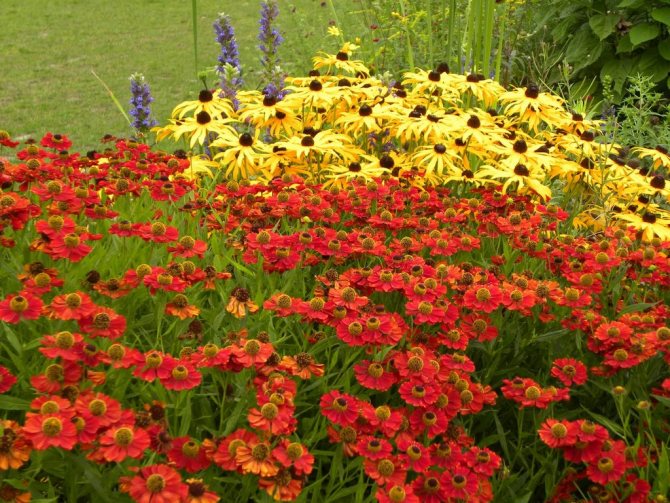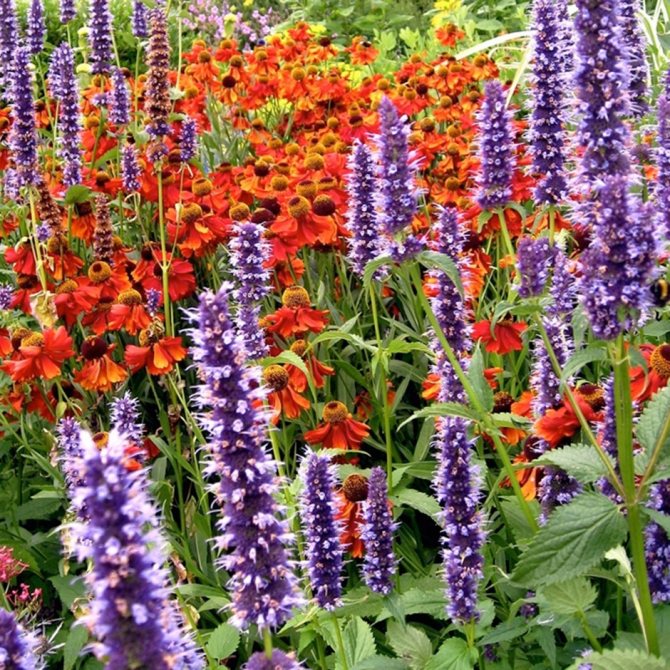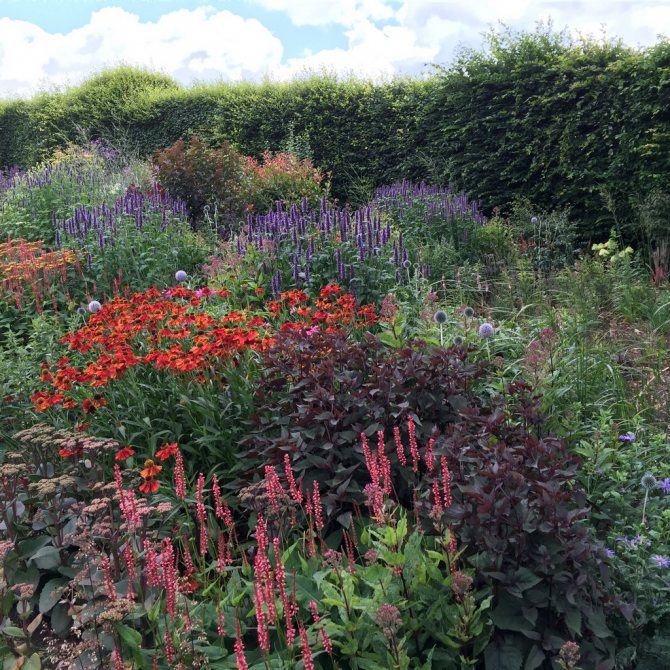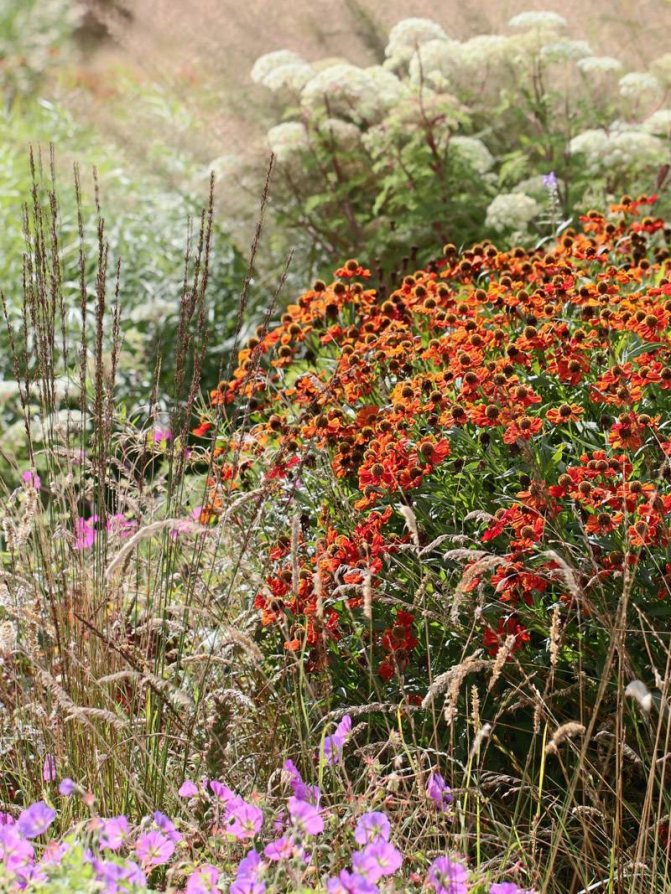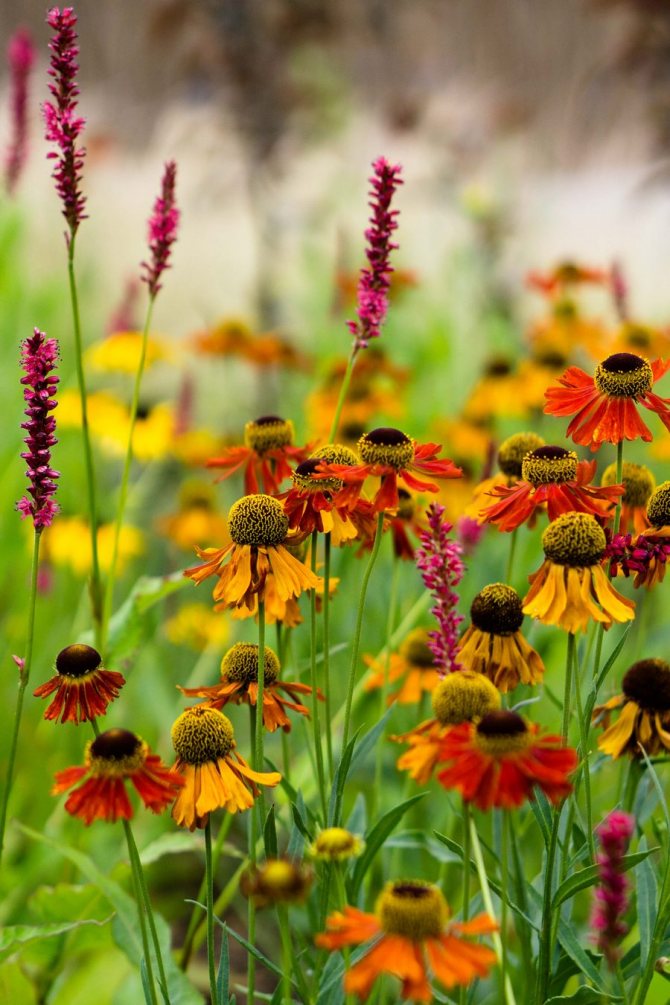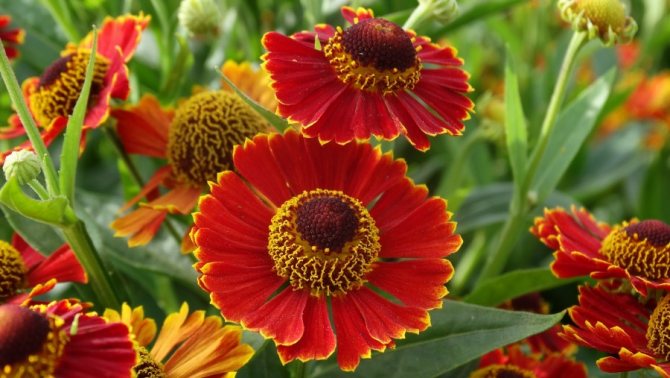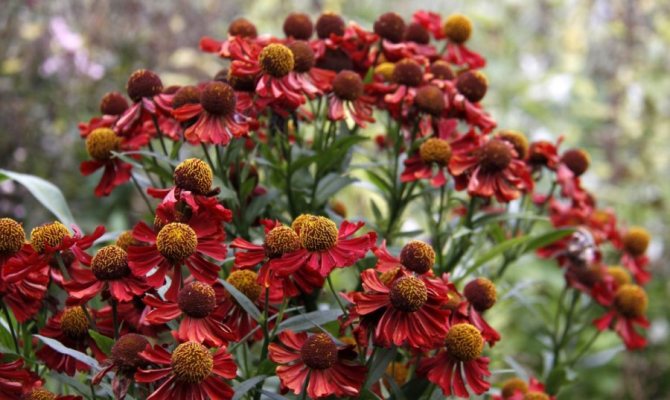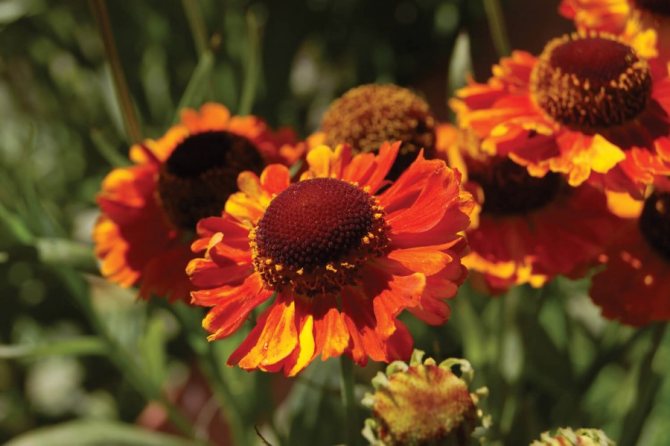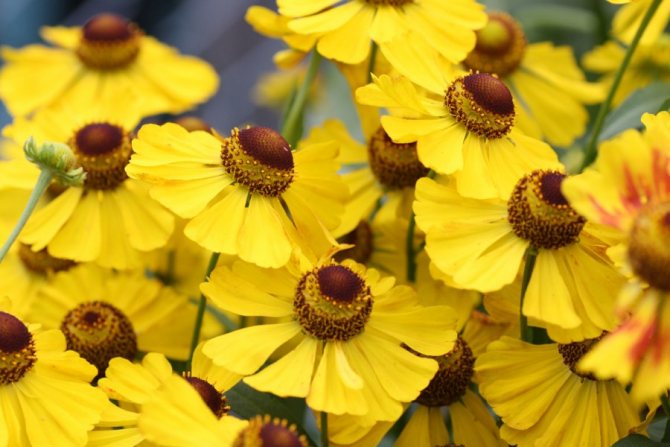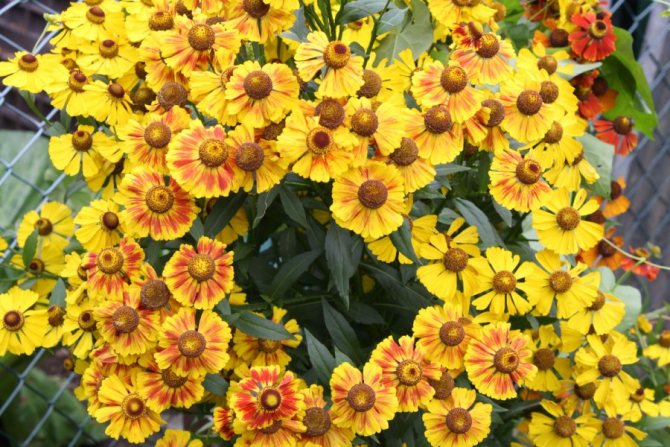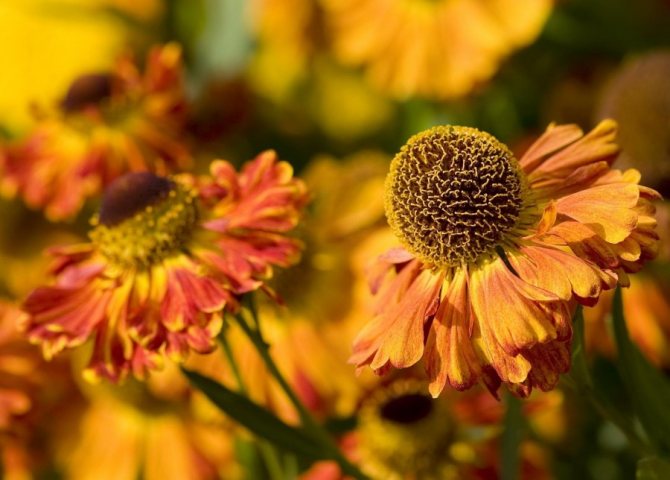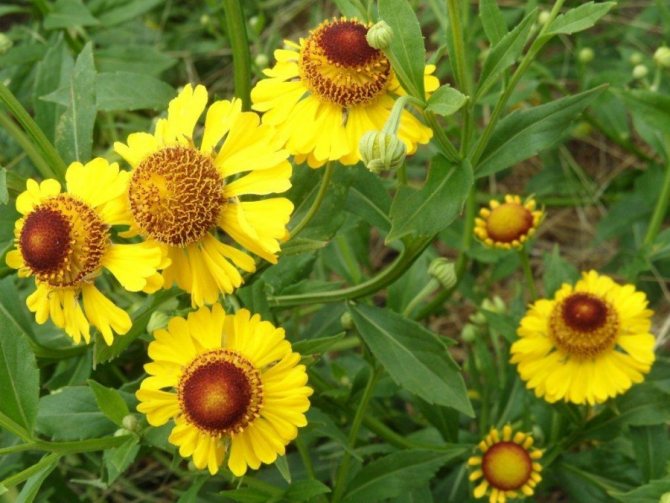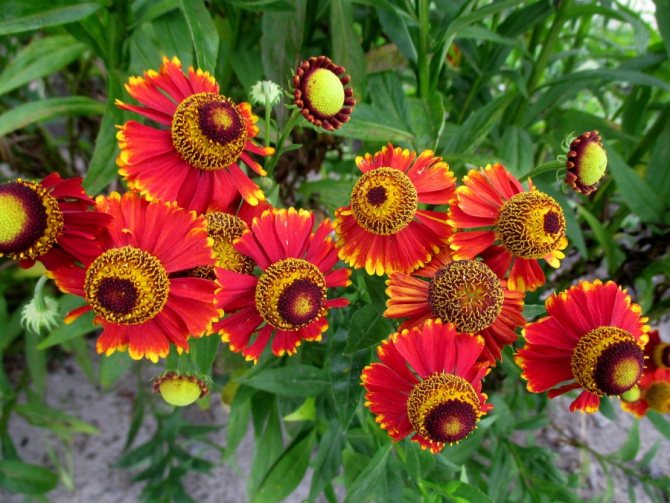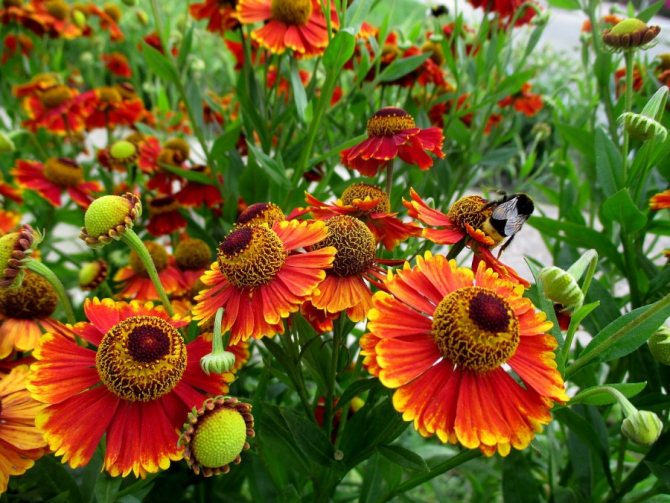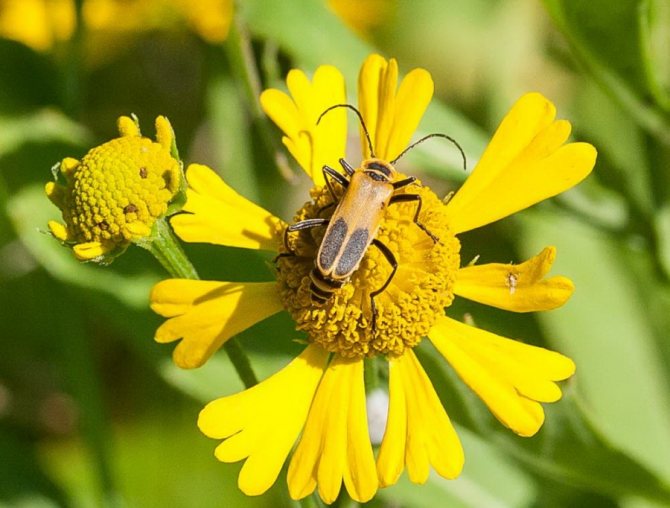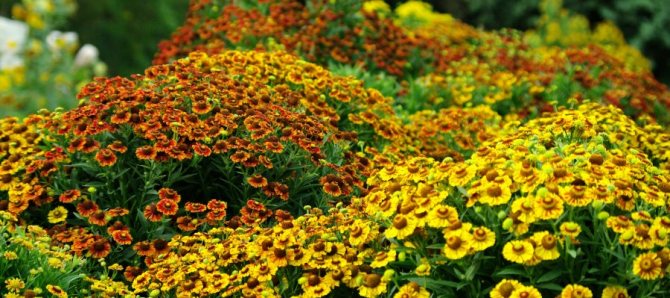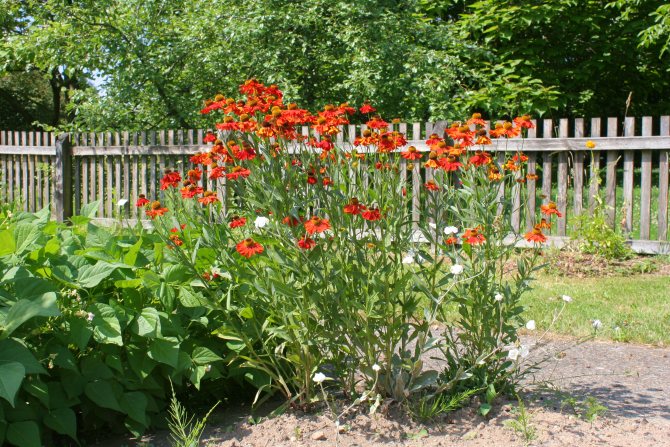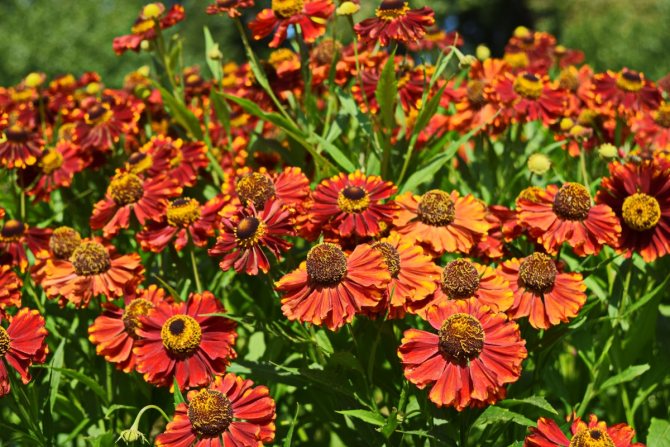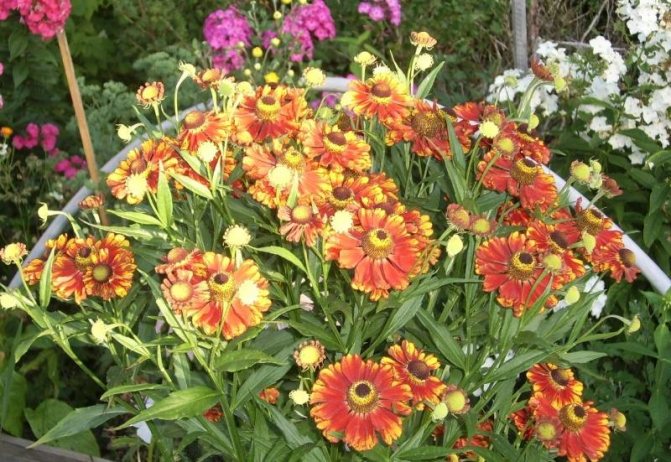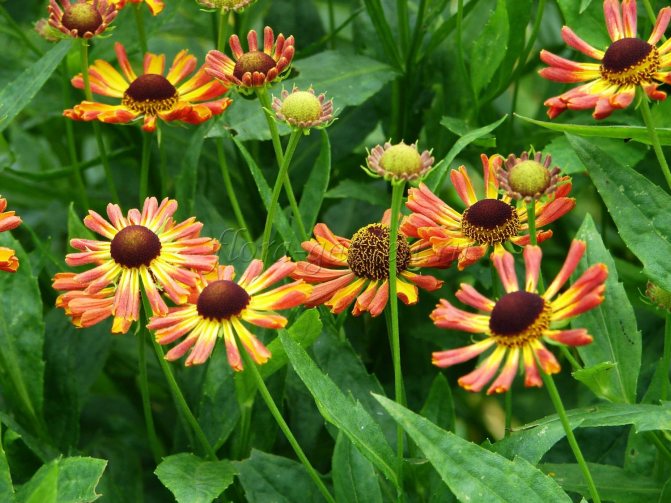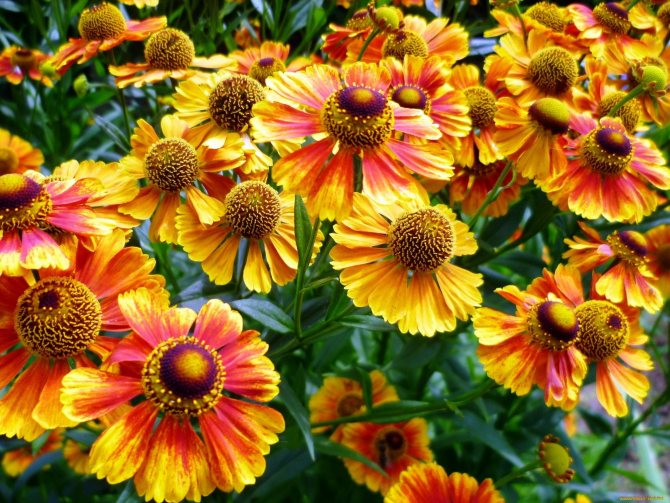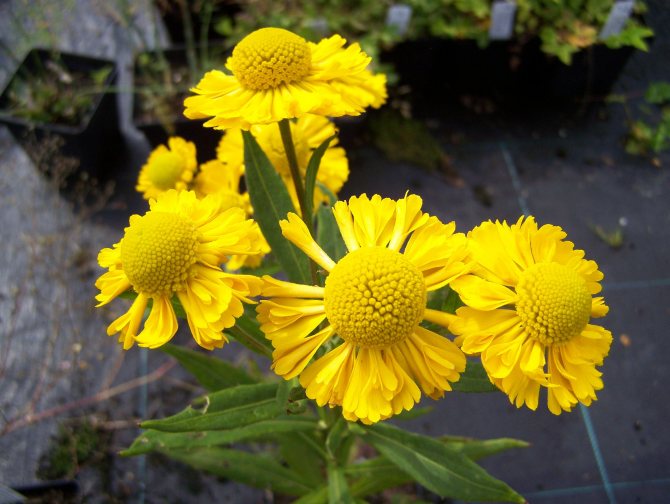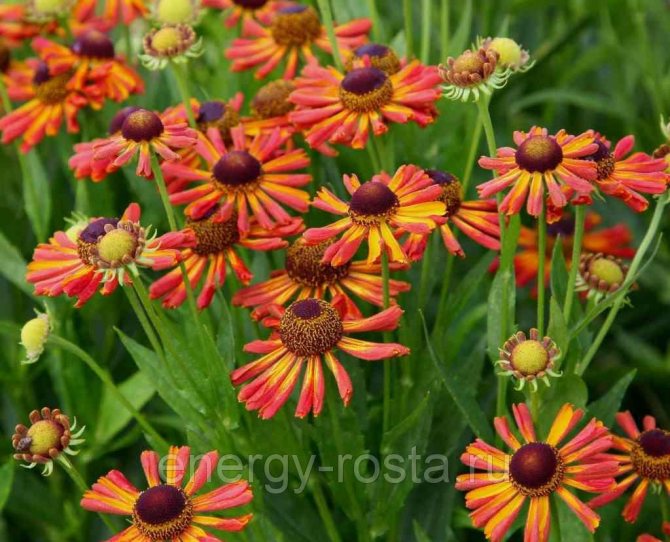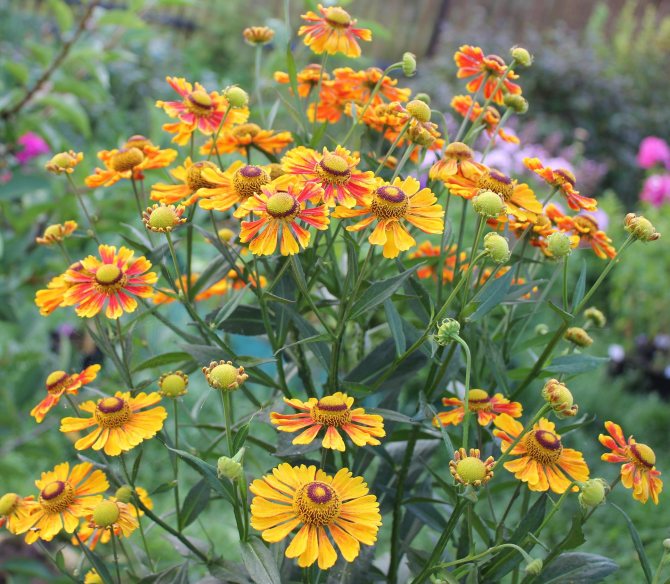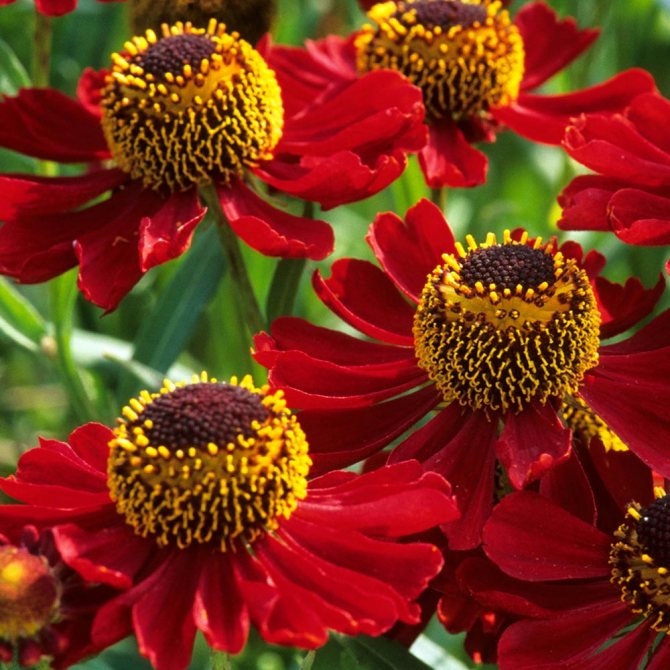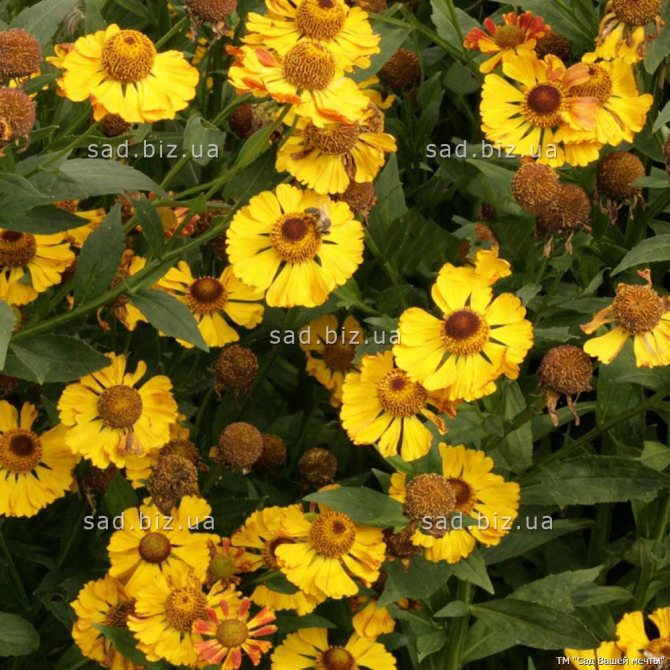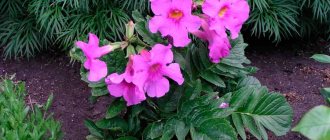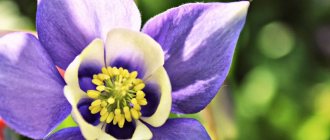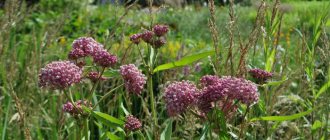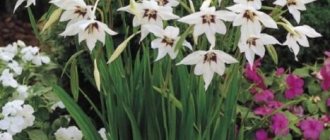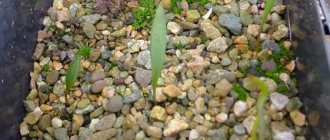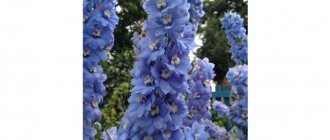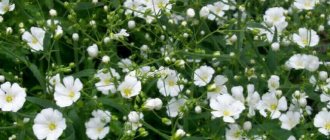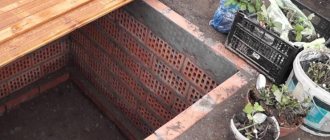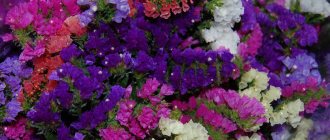Gelenium is an ornamental plant of the Astrov family, which can often be found on personal plots, city clubs and as part of multi-species rockeries. The flower has a unique property, every autumn the root system dies off, and a new plant is formed from an annual shoot. The flower is unpretentious in cultivation, thanks to the bright color of the buds, it becomes a real decoration of the garden. In the article we will consider the specifics of planting and caring for helenium.
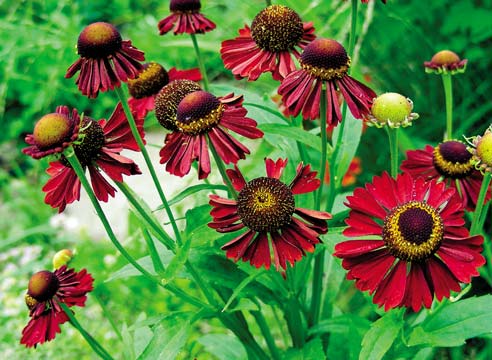
Photo of flowers Gelenium
Description of the plant
Gelenium is a genus of herbaceous annuals and perennials. The flower was first discovered in North America, where it still grows wild today. According to legend, the plant was named Helenium in honor of Helen the Beautiful, because of whom the famous Trojan War, described by Homer, began.
The plant has a strong, erect stem, its height varies from 70 to 170 cm.Along its entire length, oblong dark green leaves up to 7 cm long are alternately located.The aerial part of the gelenium annually dies off along with the rhizome, only a few growth buds remain, it is they who revive bush next spring.
Flowering may differ in terms of time depending on the variety and species. Flowers usually form in early summer and last throughout the season. Each flower is represented by a small basket, which is framed by corrugated bracts, painted in bright shades of orange, red, pink and even purple. At the beginning of autumn, fruits are formed in the form of achenes with a small airy tuft.
Autumn Gelenium
Autumn Gelenium - the most famous and widespread of all varietiesgrown on the territory of our country. Height up to 1.5 meters. Very large baskets up to 30 cm in diameter are composed of many small flowers. Many varieties of red and yellow. It begins to bloom in the middle of summer. Unpretentious.
Caring for autumn helenium is the same as for others. Autumn helenium became the ancestor of several new varieties:
- Magnificum. Low-growing variety with yellow flowers.
- "Katarina". Tall, up to 140 cm in height. Red and brown petals. Blooms in August.
- Superboom. 160 cm. Golden color. It is strewn with flowers until August.
- Altgold. Medium-sized. Flowers yellow with scarlet blotches. The core is brown. It begins to bloom in late summer.
- "Di Blonde". Tall, strong shoots up to 170 cm tall. Small red-brown flowers.
- Glutauge. A short plant with bright flowers and a red heart.
Types and varieties
Today, about 35-40 plant varieties have been described, differing in petal color, flowering period, bush height and resistance. Most of them are cultivated in different countries of the world. The most popular types:
- Autumn Gelenium... A perennial plant with an erect stem up to 130 cm high. On its surface there is a short pile, the leaves have a serrated edge, characteristic of the Astrovichs. Flowering begins in August and lasts until the first frost. The bract is usually yellow, the petals are of a very different color. Notable varieties: Altgold, Bruno and Butterpat;
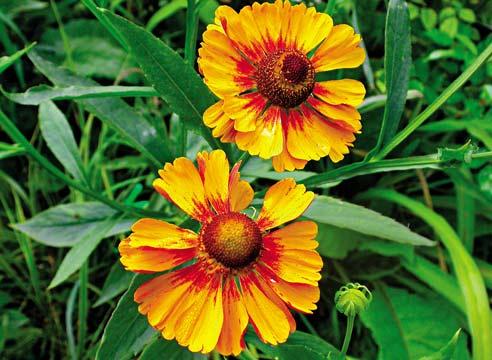

- Spring Gelenium... The stem is erect, reaches a height of 100 cm. The leaves are small, lanceolate.Flowers bloom at the end of May, are represented by a large yellow-orange basket with a diameter of 7 cm;
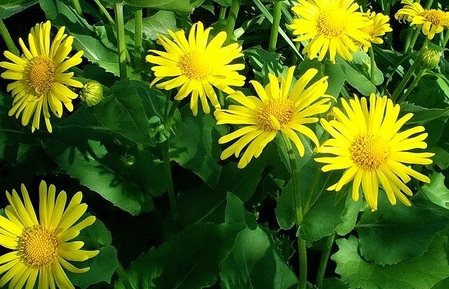

- Gelenium Chupa... Medium-sized perennial up to 90 cm high. The stem is erect, covered with alternate oblong leaves. The inflorescences are solitary and are always located on bare peduncles. The diameter of the flowers is 9 cm, the core is painted in a bright yellow shade, the petals are golden. Flowering lasts only a month, begins in mid-June;
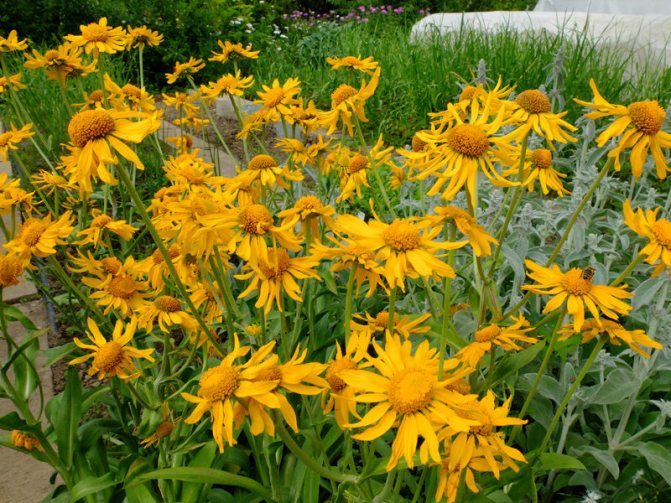

- Helenium hybrid... It combines a large number of hybrid varieties with high immunity and decorative appearance. Flowering is observed in July, the characteristics of the plant and the color of the petals depend on the variety. The most popular of these are Rothaut (red-brown petals), Cockade (red-yellow petals and brown center).


In addition, in greenhouses and in the gardens of professional florists, you can find Gelenium Gupes and Bigelow. They are capricious when grown, not suitable for beginners. When choosing a variety, you need to carefully read the description and look at the photo in order to choose a plant of the desired height and color of flowers.
Choice of place and conditions of detention
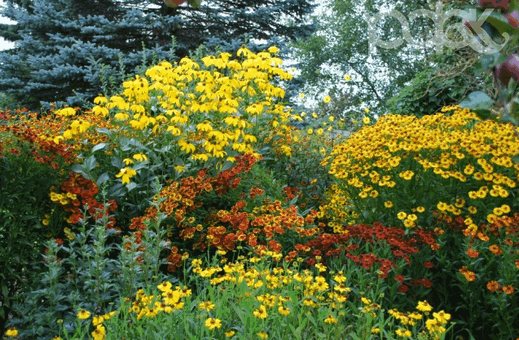

Gelenium, like other Asteraceae, is an unpretentious plant that can grow in almost any conditions. However, in order to form a spectacular flower arrangement and achieve long-term flowering, it is important to correctly choose a place for planting, taking into account the peculiarities of the culture.
Lighting and location
Gelenium prefers well-lit areas, it can grow in partial shade conditions, but the saturation of the color of the petals decreases. The site should be well sheltered from strong winds, especially when choosing tall varieties. In its natural environment, helenium grows in fertile meadow areas with moderately moist soil, therefore, conditions in the garden should be as close as possible to similar ones.
In landscaping, helenium can be used in densely planted flower beds, and lush varieties are suitable for single planting. Low-growing species are usually planted at the front of a mixborder or to frame curbs, while tall varieties are best seen in the background of a multi-species flower bed.
Temperature
The plant in adulthood is unpretentious to temperature conditions, can survive slight changes in heat, tolerate slight frosts. The optimum temperature for seedlings should be between 18-22 ° C, after active growth there are no restrictions. The recommended temperature regime throughout the entire growing season is 14-20 ° C.
Air and humidity
Like other members of the Astrov family, helenium can withstand the influence of drafts and strong winds. When planting in an open area for tall varieties, it is recommended to install a support to avoid damaging the stem in the presence of strong winds.
Gelenium prefers moderate soil and air humidity, additional spraying in open ground should be carried out if dry weather lasts for 5-7 days. In the climate of Russia, to maintain optimal humidity, it is enough to observe the irrigation regime and mulch in a timely manner.
Priming
To ensure comfortable growth and abundant flowering, it is advisable to choose areas with fertile and light soil. The soil should be well aerated, with a neutral or slightly acidic pH. It is not recommended to plant a plant if groundwater lies nearby or there is a reservoir, as this increases the risk of decay of the root system.
The substrate should be nutritious and drained, before planting, it is advisable to dig up the area to the depth of the shovel bayonet, add organic and mineral compositions, depending on the degree of fertility. To increase aeration, you can add fine river sand or peat at the rate of 3 kg per 1 m2.
Perennial heleniums in flower garden design
Geleniums, planted in large curtains, look most effective. The color spot they create (of course, on condition of mono planting) gives the mood of the whole composition.
Low-growing varieties of gelenium can be placed in the foreground of a flower garden or border, and high ones will provide a wonderful background or second tier in a complex mixborder with the participation of ornamental shrubs, autumn-flowering herbaceous perennials and cereals.
What colors does helenium match in a flower bed?
At the end of summer, the blooming geleniums will be accompanied by paniculate phlox, loosestrife, monarda, late-flowering lilies, rudbeckia, blueheads, agastakha, echinacea. And closer to September, the turn of perennial asters, chrysanthemums and various cereals (molinia, pike, pennisetum, etc.) will come.
Perennial Gelenium is a completely non-capricious flower, and if you take into account all the nuances of caring for it, it will make your garden unusually cozy and warm!
<2020 - 2020, Planting a Garden. All rights reserved.
When to plant
Planting dates depend on the growing method and climatic conditions in the region. Seeds in the seedling method are best planted in the second half of February, so that by the end of spring frosts and snow melt, young plants are ready for transplantation.
In open ground, helenium can be planted, starting from mid-April in the southern regions, in the north, you must wait until the beginning or mid-May. The main condition is the absence of snow on the site, as well as the achievement of a stable warm temperature during the day at a level of 10-12 ° C.
Helpful tips for caring for your helenium
- The acquisition of seedlings should be dealt with in the spring. In this case, the plants must be healthy.
- The shadow is fatal to helenium. He needs the sun all day.
- To obtain spreading bushes in the spring, pinch off the tops of the shoots.
- The soil should be rich in nutrients.
Rejuvenation of the bushes is carried out in spring or autumn. To do this, the plant is dug up, then it is divided and planted again.
Growing helenium from seeds
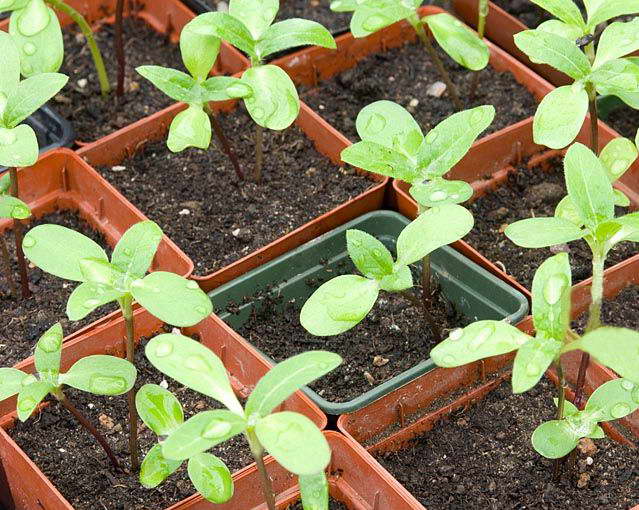

Planting material is best purchased at the store, since self-collected seeds have a very low germination rate. Before starting work, it is necessary to slightly moisten the seeds; for this, the seeds are wrapped in a slightly damp cloth or napkin for 1-2 hours.
After the procedure, they should be treated with a 1% solution of potassium permanganate for disinfection. For planting gelenium, you can use a ready-made substrate for flower crops or prepare it yourself by mixing 1 part of fertile land with 1 part of sand and peat. Planting technology for seedlings:
- Pour soil into a common container and slightly moisten it. The seeds are very small, so they need to be kneaded on the surface, and then sprinkled with a light layer of sand up to 4 mm thick.
- The container with seeds should be covered with foil or glass, removed to a warm and well-lit place. Until the first shoots appear, you need to regularly ventilate and moisten the soil. Daylight hours for the formation of plants should be at least 10 hours.
- The first shoots should appear in 8-12 days. At this moment, you can remove the shelter, be sure to monitor the level and duration of illumination. A pick into individual containers is carried out when 3 true leaves are formed.
Before transplanting the seedlings to a permanent place, it is recommended to harden by taking the containers out into the open air for 2-3 hours daily. Gelenium is transplanted together with a lump of earth into prepared holes up to 10 cm deep. The optimal distance between the bushes is 30 cm, and between the rows you need to leave a place 35-40 cm wide, since the plant grows strongly over time.
After planting, it is recommended to carry out a shelter (agrofibre, spruce branches), which is preserved in the first 5-7 days of growth.The first feeding is carried out no earlier than after 14 days. After planting, the soil should be immediately mulched and watered abundantly with warm water. Seed Gelenium will only begin to bloom profusely in the second year of growth.
Landing in open ground
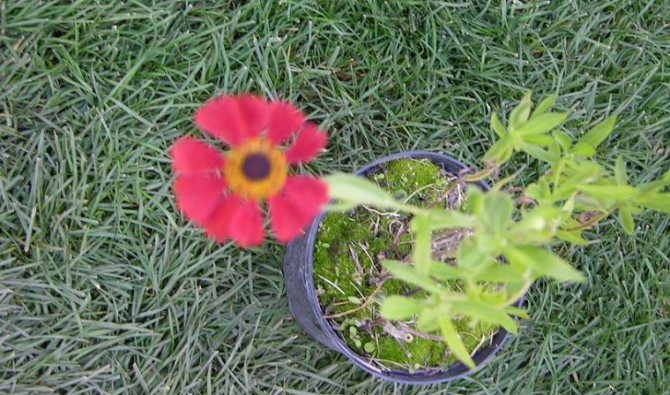

In warm regions, it is possible to plant helenium directly in open ground. First you need to prepare the site, and then make individual pits for each plant with an interval of 30 cm. After that, the prepared seeds are planted, sprinkled with a light layer of earth. It is imperative to provide shelter to avoid exposure to low temperatures. After the appearance of the first leaves, the covering material can be removed, and the soil can be mulched with humus, sawdust or peat.
Rules for care and cultivation in the garden
If you choose the right place for planting and follow the agricultural technology of growing seeds, then the plant will have high resistance to adverse conditions, practically does not need care. When growing gelenium, only a minimum of effort is required - to maintain soil moisture, prepare the plant for winter and apply top dressing on time.
Watering
The plant reacts poorly to a lack of moisture in the soil, so watering should be regular and abundant enough. The recommended regimen is 2-3 times a week at the rate of 5 liters per plant. In dry and dry weather, watering should be done more often. At the same time, water stagnation in the soil should not be allowed, since this leads to decay of the root system. The water must be clean and settled. It is better to use rain or melt water, as it has a softness and acidity favorable to plants.
Top dressing
Fertilizer is applied three times during the season. The first feeding is carried out in the spring before active growth begins; it is recommended to use organic matter, for example, an aqueous solution of mullein or bird droppings. When growing on a poor substrate, you can additionally add a mixture of potassium sulfate and urea at the rate of 10 g of the product per 10 liters of water.
The second dressing is used during the formation of buds, for this it is best to use complex liquid formulations for the root method of application. It is not recommended to abuse nitrogen fertilizers, which will lead to increased growth of greenery and a decrease in the quality of flowering. The last feeding is carried out before winter in order to strengthen the plant's immunity. For this, potassium sulfate and superphosphate are used at the rate of 10 g of the product per 10 liters of water, up to 5 liters of the product are required per 1 m2.
Loosening, mulching
Gelenium loves loose and light soil, so a dry crust should not be allowed to form on the surface. Loosening is carried out as needed, the procedure must be carried out very carefully, trying not to damage the surface roots of the plant. At the same time, you need to weed the area and lay a layer of fresh mulch, which is suitable for hay, sawdust or humus. On average, loosening is carried out 3-5 times per season.
Pinching, pinching, pruning
The formation of the helenium bush is carried out only for sanitary purposes. Throughout the season, yellowed and deformed leaves and shoots should be pinched. In the first year, it is imperative to remove all inflorescences, and in subsequent seasons, it is recommended to pinch already faded buds to enhance flowering. To make the bush more branchy, experienced gardeners recommend gently pinching the tops of the stem at the beginning of the season.
Transfer
The plant can comfortably grow and develop for 4-5 years in one place without the need for transplanting. The procedure is carried out for rejuvenation, as well as reproduction of the plant by dividing the bush. The work is best done in the fall, before preparing for winter, or in early spring, before the formation of growth buds. Gelenium transplant algorithm:
- Dig a bush under the root and carefully remove it along with a lump of earth.
- Cut off overgrown roots, as well as all deformed and old parts of the plant.
- Plant the bush in a new place in a prepared hole up to 30 cm deep. The planting level should be left the same, trying not to deepen the root collar much.
- Cover the plant with a fertile layer of earth, pour abundantly with warm water and mulch.
If you transplanted in the spring, then this year the flowering may be less pronounced and intense. Starting from the second year of growth in a new place, the plant is completely restored.
Fertilization and feeding
In order for helenium to show itself in all its glory, it is necessary to fertilize a flower bed with a perennial three times per season:
- In late spring, the flower garden is fed with urea and potassium sulfate.
- During the flowering period, a liquid mullein is used as a fertilizer - 3 liters of an aqueous solution per 1 square meter. area.
- In October, in order to stimulate the formation of buds of the next season, fertilization of the beds is carried out with superphosphate and potassium sulfate. This will require about 5 liters of top dressing 1 square meter. flower garden.
In addition, before planting, the place for growing helenium must be filled with organic fertilizers: compost, rotted manure.
Growing features
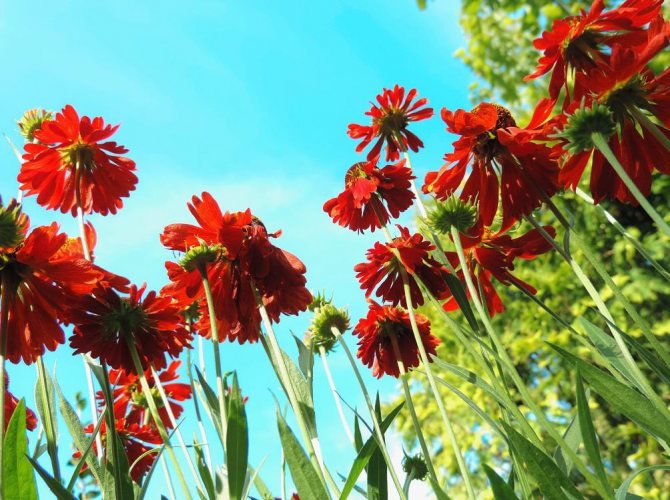

Gelenium is distinguished by strong immunity and resistance to diseases and pest infestation. Problems are usually noted only if the rules of care, agricultural cultivation techniques are not followed. The most common culture is affected by chrysanthemum nematodes.
The pest infects leaf plates, as well as flower buds. Leads to wilting of the plant and its death within only 1 month. If an infection is found, it is necessary to remove all affected parts of the plant, and then burn them. As a preventive measure, planting treatment with slaked lime or colloidal sulfur is used. Spraying is recommended twice a season.
Gelenium is a real decoration of the site. Thanks to the bright and rich color of the buds, the plant fits into any design, and the variability of the varietal diversity allows the crop to be used for a variety of purposes. The flower requires minimal maintenance, it can grow even in adverse conditions. When growing, you should competently approach the choice of a site, observe the irrigation regime and apply top dressing according to the scheme.
Gelenium pests and diseases
The unpretentious nature and strong immunity allows helenium to withstand many misfortunes and diseases. However, some of them still pose a great danger to him. For example, you can take chrysanthemum nematode, the vital activity of which is accompanied by damage to leaves and flower buds. You need to deal with such a problem quickly and radically, cutting off and burning the affected areas. Preventive measures include adding a small amount of hydrated lime to the soil composition. If we are talking about the prevention of fungal diseases, it is enough to provide the flower with competent watering and not overdo it with moisture.
The high moisture content in the soil contributes to the rapid reproduction of fungal microorganisms and the formation of putrefactive processes. Be careful and try to properly care for the plant in order to prevent such irreparable consequences.

